Belkin F5U035 Wireless USB PC to PC adapter User Manual UserManual edited v2
Belkin International, Inc. Wireless USB PC to PC adapter UserManual edited v2
Belkin >
F5U035 Users Guide Document
Revision 0.25 - 1 -
Belkin
Wireless USB P.C. to P.C. Adapter
Model F5U035
Revision 0.25 - 2 -
Table of Contents
Introduction...............................................................................3
Features .................................................................................3
Operating System Supported .....................................................3
System Requirements...............................................................3
Package Includes .....................................................................3
Technical Specification.................................................................4
How to insert the Belkin Dongle to a computer................................5
How to use the Belkin Dongles......................................................7
Install the Belkin Dongle Software ..............................................9
Operating the Belkin USB Dongles............................................... 15
How to use Belkin(R) WiMedia Manager........................................ 17
Uninstallation ........................................................................... 18
Uninstall Belkin(R) Wireless UWB Link Software.......................... 18
Uninstall Belkin(R) Wireless UWB Link Drivers ............................18
Uninstall Intel(R) UWB Device Firmware Utility (DFU) Driver (This
may not be required).............................................................. 18
Channel Selection .....................................................................19
Multi-Channel Operations ........................................................ 19
Troubleshooting........................................................................ 20
Customer Support..................................................................... 20
Information..............................................................................20
FCC Statement ...................................................................... 20
Revision 0.25 - 3 -
Introduction
Congratulations and thank you for purchasing the Belkin(R) Wireless USB 2.0 PC to
PC Adapter. This revolutionary product lets you connect your computer or laptop
wirelessly to other computers and perform operations such as fast file transfers,
video streaming.
Please review this User Manual carefully so that you are sure to get the most from
your Wireless UWB Adapter.
Features
- Wireless Connectivity between computers and or laptops.
- Connect almost instantly without any access point.
- Data transfer rate of up to 480 Mbps* at a distance of 3 meters away
- Data transfer rate of up to 110 Mbps* at a distance of 10 meters away
- Create your own Personal Area Network and exchange files, play videos
Operating System Supported
- Microsoft* Windows Vista
- Microsoft* Windows XP with Service Pack 2
System Requirements
- Personal Computer with USB 2.0 port
- 128 Megabytes Physical Memory
Note: Do not plug the Belkin dongle into USB port which is not USB 2.0.
Package Includes
- Belkin(R) Wireless UWB Adapter – (Qty 2)
- USB Flexible Connector – (Qty 2)
- Installation CD-ROM
- User Manual
Revision 0.25 - 4 -
Technical Specification
Model Number F5U035
UWB Chipset Alereon Baseband, RF
Intel(R) Wireless UWB Link 1480M MAC
Antenna On-board Omni-directional Antenna
Operating Temperature 00 C to 550 C
Operating Range Up to 30 Feet (10 Meters)
Power Mode USB Bus powered.
PHY Data Rate 480 Mbps (Automatic Rate Adaptation)
Frequency Range 3.1 GHz – 4.8 GHz Supporting 3 sub-bands 528 MHz
each
RF Modulation Multiband OFDM
PHY Compliance Complies with WiMedia(R) PHY Specification Revision 1.0
MAC Compliance Complies with WiMedia(R) MAC Specification
Revision .85
FCC Compliance Complies with FCC 47 CFR Part 15, Subpart F Section
15.519
USB Compliance Complies with USB 2.0 Specification
OS Compliance Complies with Microsoft* Windows* XP SP2, Vista
Co-existence Coexists with other standard WiMedia devices
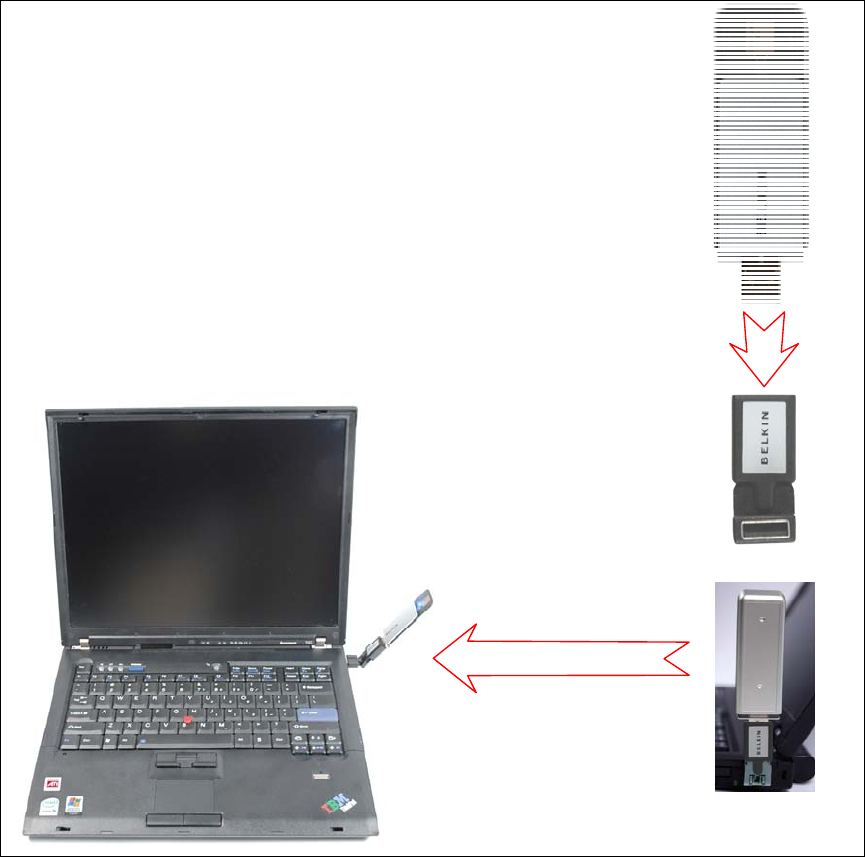
Revision 0.25 - 5 -
How to insert the Wireless USB 2.0 PC to PC Adapter to
a computer
Insert the dongle into the USB adapter as shown in the diagram below. Insert the
adapter with the dongle into the USB port of the computer.
B6473-01
Belkin® Wireless UWB
Adapter
Belkin® USB Adapter
Figure 1 How to Insert Dongle into USB Adapter
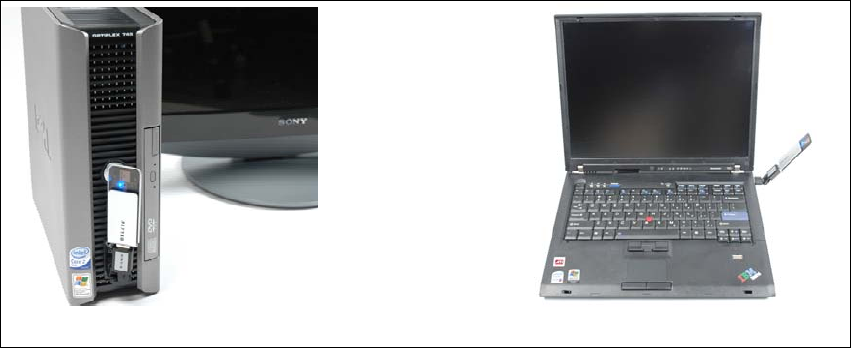
Revision 0.25 - 6 -
Recommended ways to connect the adapter to a computer
B6474-01
Figure 2 Recommended Dongle Orientation
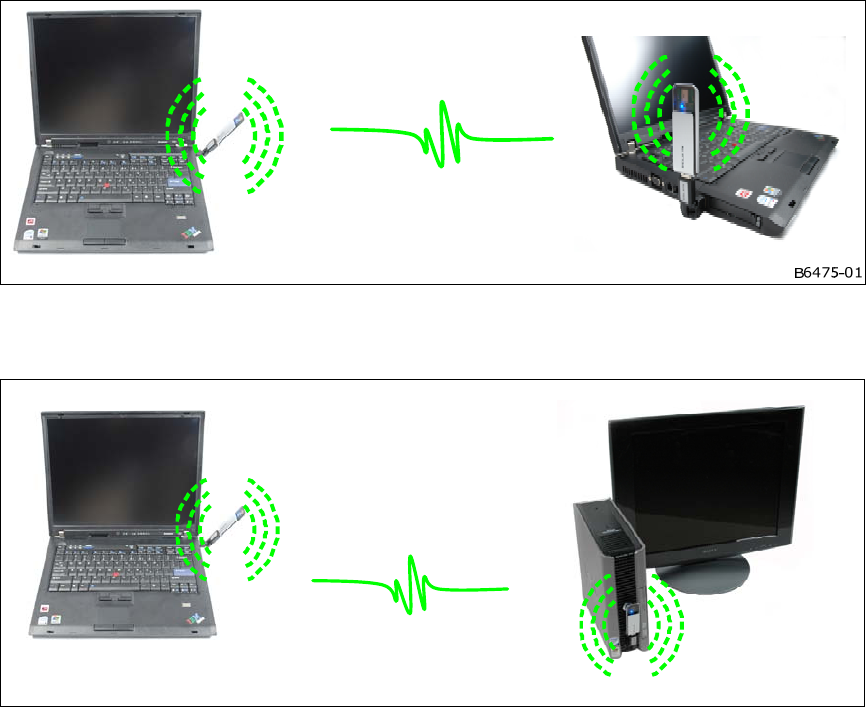
Revision 0.25 - 7 -
How to use the Wireless USB 2.0 PC to PC Adapter
The Wireless USB 2.0 PC to PC Adapter can be used with laptops or desktop systems
to communicate wirelessly. A few scenarios have been listed below to give you an
idea of how the adapter can be used to share information almost instantly and
improve your productivity.
Figure 3 Laptop to Laptop Wireless Communication
B6476-01
Figure 4 Laptop to Computer Wireless Communication
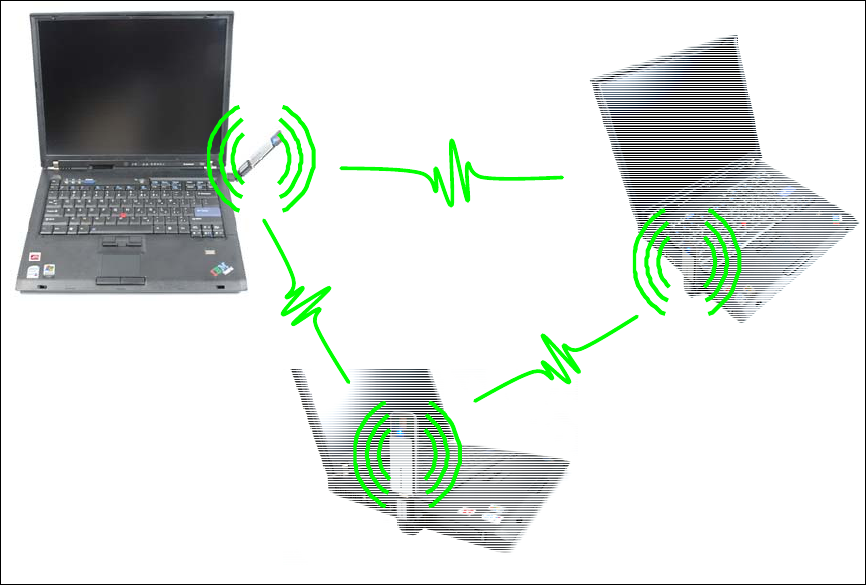
Revision 0.25 - 8 -
B6477-01
Figure 5 Multi-Laptop communication creating a Personal Area Network
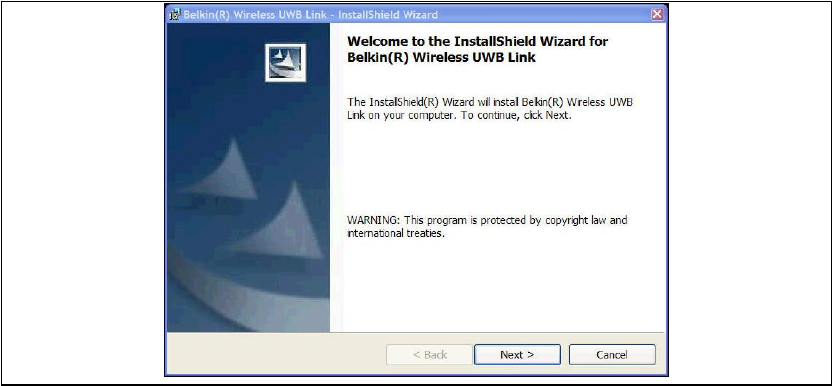
Revision 0.25 - 9 -
Installation
The following steps will illustrate the procedure to install the software and the
Wireless USB 2.0 PC to PC Adapter for the first time.
Note: Do not attach the USB dongle before the software is installed.
Step 1 Install the software from the CD-ROM onto your computer.
Step 2 Connect the USB dongle to the PC or laptop and complete the multi driver
installation.
Step 3 After successful installation, now you are ready to use the Belkin dongles for
copying files, or streaming video.
Install the Wireless USB 2.0 PC to PC Adapter Software
1. If this is not the first time the software has been installed, please uninstall the old
version of the software. Click Start -> Control Panel -> Add or Remove Programs.
In the Add or Remove Programs Window, scroll down to select Belkin(R) Wireless
UWB Link software and click Remove button to delete the software.
2. Install the Wireless USB 2.0 PC to PC Adapter software by running the
installation file setup.exe provided in a CD-ROM as part of the package.
3. If the system does not have Microsoft* .Net Framework, Version 2.0, the
installation file will install .Net Framework first and then proceed to install the
Belkin Wireless UWB Link software.
4. The InstallShield Wizard will be displayed as shown in the figure below. Click Next
to proceed.
Figure 6 InstallShield Wizard
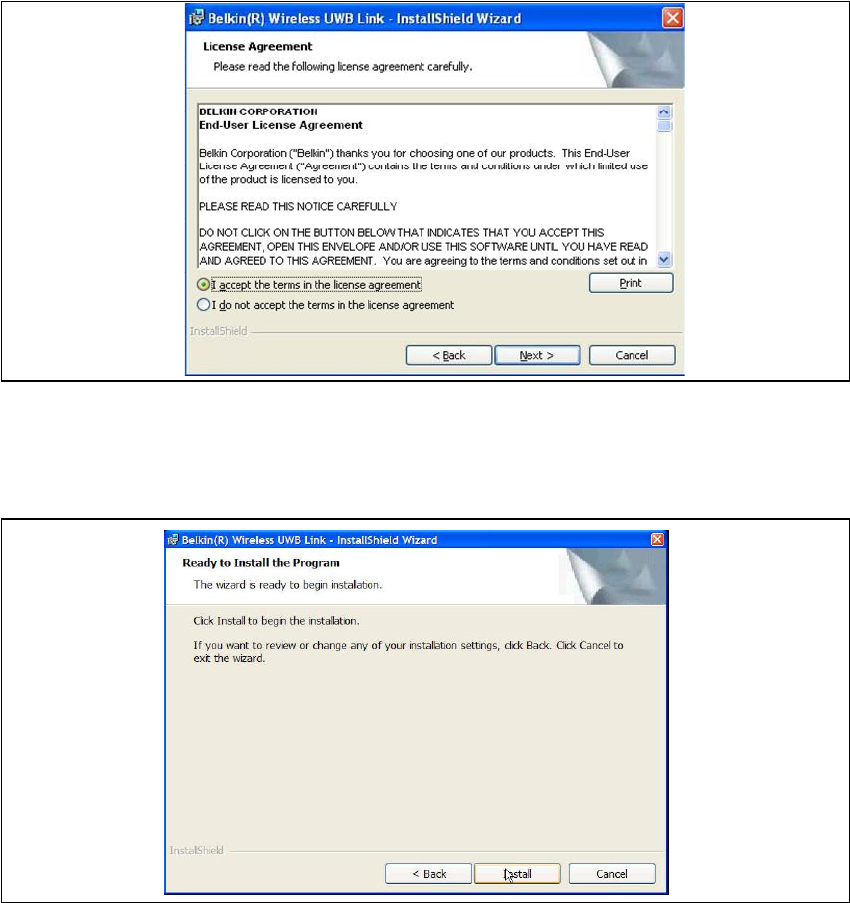
Revision 0.25 - 10 -
5. InstallShield Wizard will display the License Agreement Window as shown below.
If you agree to use the software, Click ‘I agree the terms in the License
Agreement’ and Click Next to proceed.
Figure 7 InstallShield – License Agreement
6. InstallShield will display the ‘Ready to Install the Program’ window as shown
below. Click Install to proceed.
Figure 8 InstallShield – Ready to Install the Program
7. The InstallShield wizard will display a warning message “The Software you are
installing has not passed Windows Logo testing to verify its compatibility
with Windows XP”. This message can be safely ignored, as this will not cause
any harm to your system. Proceed with the installation by clicking Continue
Anyway.
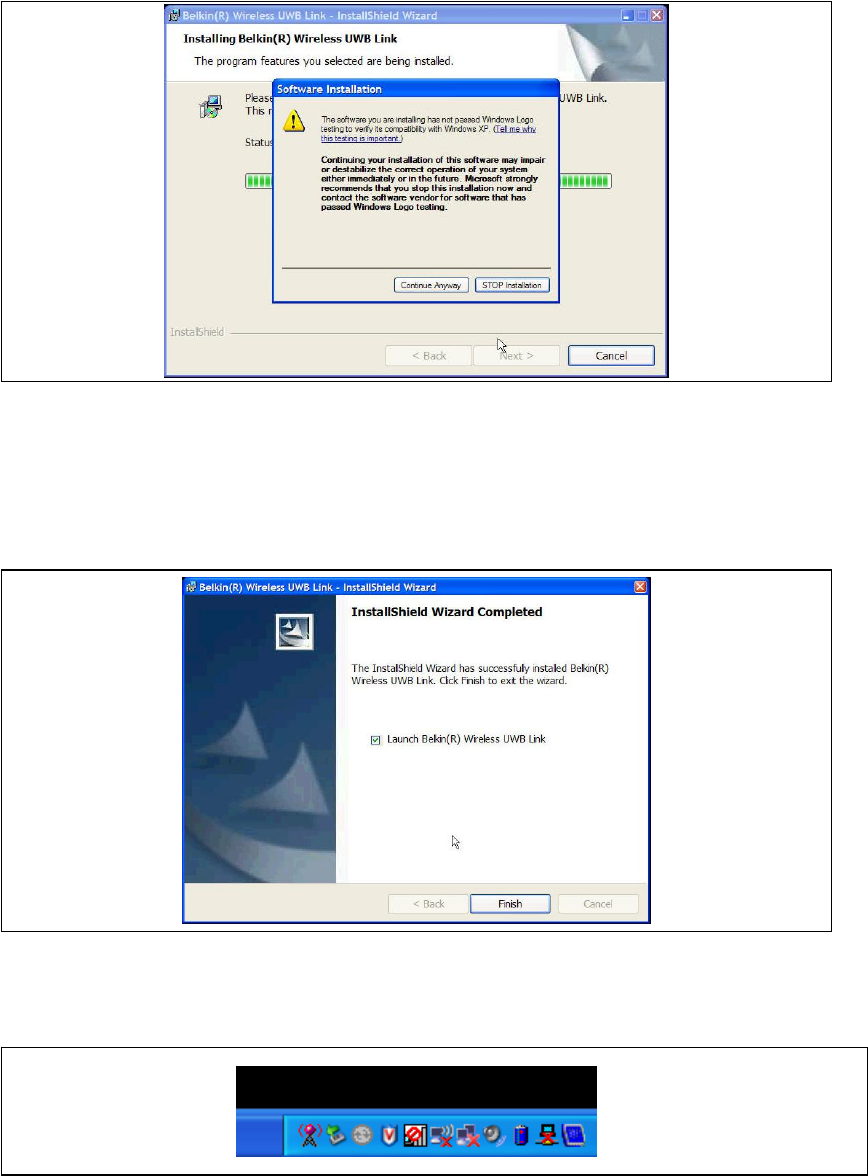
Revision 0.25 - 11 -
Figure 9 InstallShield – Warning Message
8. InstallShield will prompt two more times with the warning message, Click
Continue Anyway.
9. Now the InstallShield has completed the installation of the Belkin Wireless UWB
Link software as shown in the figure below. Click Finish to close the Window.
Figure 10 – InstallShield Wizard Completed
10. At this point, WiMedia Manager will be running on the Notification Area of the
Windows Status bar as shown in the figure below.
Figure 11 – WiMedia Manager
11. After successful installation, the Belkin Wireless UWB Link software will be copied
into the default folder location “C:\Program Files\Belkin\Wireless UWB
Link”.
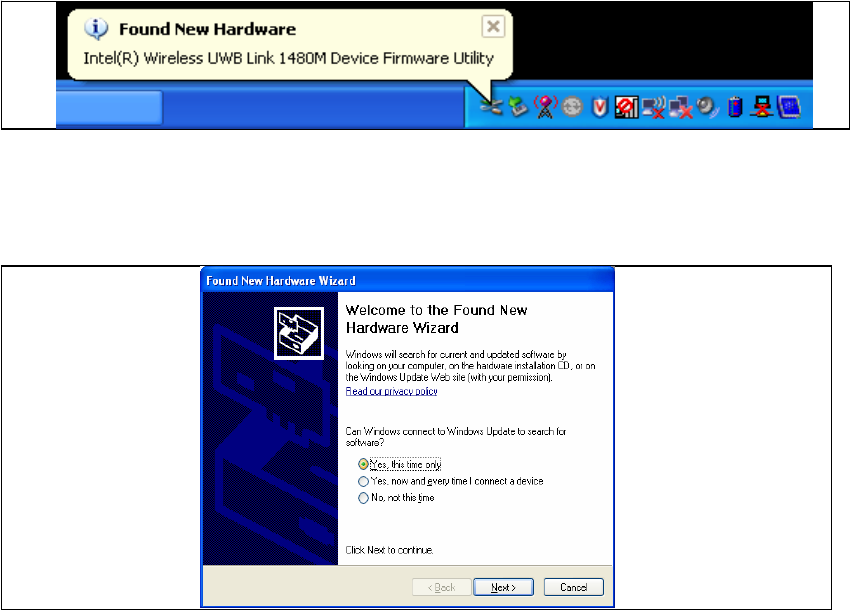
Revision 0.25 - 12 -
12. Now insert the Belkin dongle to the USB 2.0 port of the personal computer.
13. Windows* will recognize a new hardware plugged into the system and invoke
“Found New Hardware” Wizard prompting to install the software for Intel(R)
Wireless UWB Link 1480M Device Firmware Utility.
Figure 12 Found New Hardware - Intel(R) Wireless UWB Link 1480M Device
Firmware Utility
14. Choose ‘Yes, this time only’ and Click Next to proceed.
Figure 13 – Found New Hardware Wizard
15. Found New Hardware Wizard will prompt you to insert installation CD or floppy
disk. Choose the option “Install the Software automatically (recommended)” and
click Next to proceed.
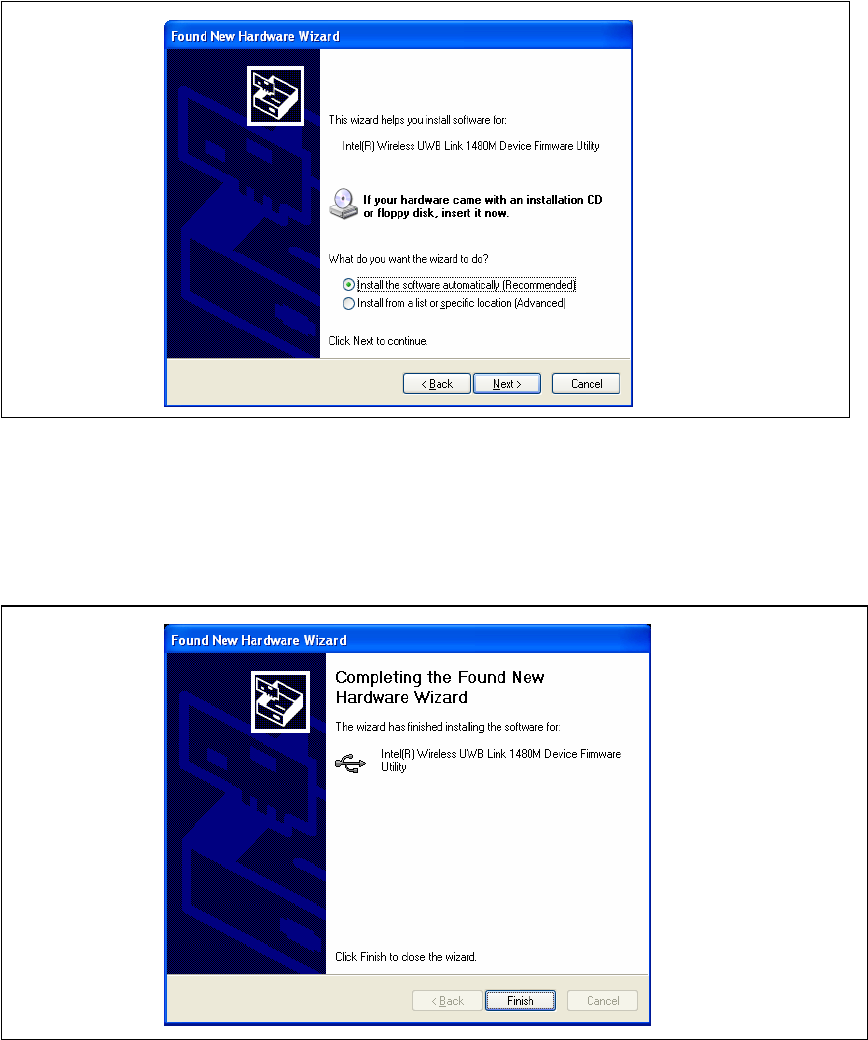
Revision 0.25 - 13 -
Figure 14 - Found New Hardware Wizard – Prompting to Insert installation
CD
16. Found New Hardware Wizard will display a warning message. This message can
be safely ignored and click Continue Anyway to proceed.
17. Now the Found New Wizard has installed the software “Intel(R) Wireless UWB
Link 1480M Device Firmware Utility”. Click Finish to close the Window.
Figure 15 - Found New Hardware Wizard Completed Software Installation
18. Windows will recognize a new hardware plugged into the system and invoke
“Found New Hardware” Wizard prompting to install the software for Intel(R)
Wireless UWB Link 1480M Control Driver. Repeat the same steps as followed with
the first software installation.
19. Windows will recognize a new hardware plugged into the system and invoke
“Found New Hardware” Wizard prompting to install the software for Intel(R)
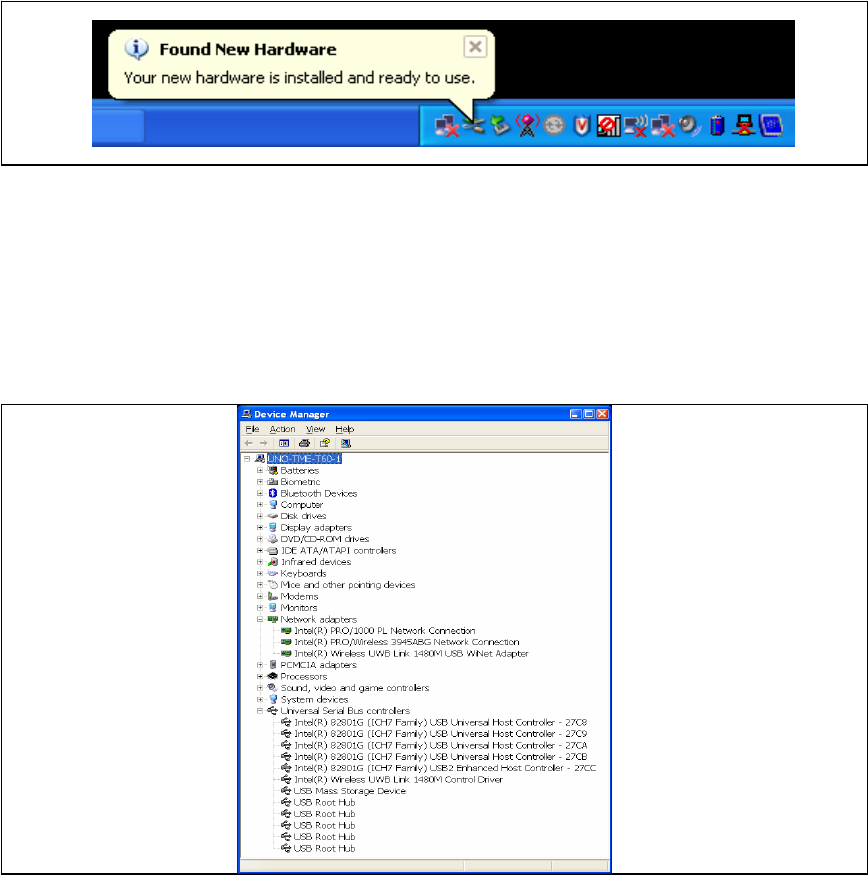
Revision 0.25 - 14 -
Wireless UWB Link 1480M USB WiNet Adapter. Repeat the same steps as
followed with the first software installation.
20. After the software installation, Windows will prompt the New Hardware is ready
to use as shown in the figure below.
Figure 16 – Found New Hardware Wizard – New Hardware ready to use
21. To verify installation, go to the device manager by clicking
Start Menu -> Control Panel -> System (Under Classical View) -> Choose Hardware
Tab -> Click Hardware profiles at the bottom of the window.
22. Look for the devices “Intel(R) Wireless UWB Link 1480M Control Driver”
and “Intel(R) Wireless UWB Link 1480M USB WiNet Adapter” listed as
indicated in the figure below.
Figure 17 Device Manager displaying Control and Network drivers
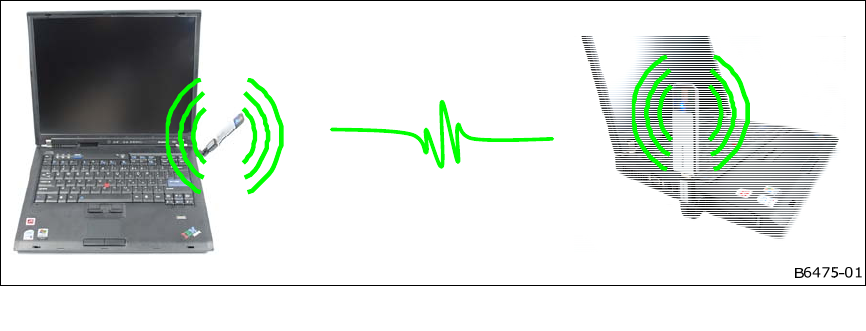
Revision 0.25 - 15 -
Operating the Belkin USB Dongles
Figure 18 End-to-End Connectivity with Belkin USB Dongles
1. Boot the PCs Laptop A and laptop B to Windows*.
2. Ensure the WiMedia Manager is running by viewing the WiMedia Manager
icon on the Notification Area on the Status bar of Windows.
3. Open the WiMedia Manager by double clicking the WiMedia Manager.
4. Under General Tab, Ensure the channel numbers are the same for Laptop A and
laptop B.
5. Insert the Belkin dongle on the USB port of Laptop A as well as Laptop B.
6. The Belkin dongle will be enumerated as a USB device under normal operations
for respective laptops as indicated in the Figure 17.
7. In General View, the remote UWB device will be listed under the UWB
Neighbourhood column.
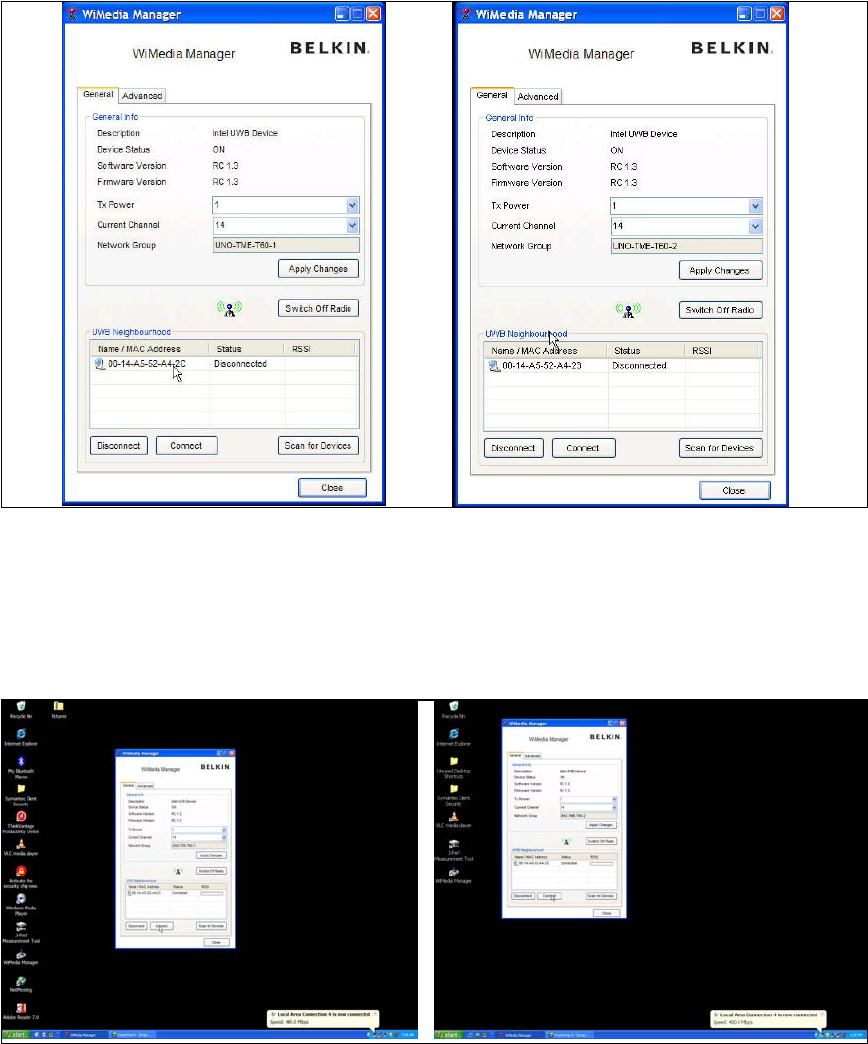
Revision 0.25 - 16 -
Figure 19 WiMedia Manager listing remote devices
8. To Connect to the remote device, select the remote device and click Connect.
Similarly perform the same action on the remote PC.
9. Upon successful connection, the Windows* notification bar would indicate “Local
Area Connection # Connected” (Note 1).
Figure 20 WiMedia Manager – When UWB Device is Connected
10. Now you can copy files or share a video at a very fast speed!
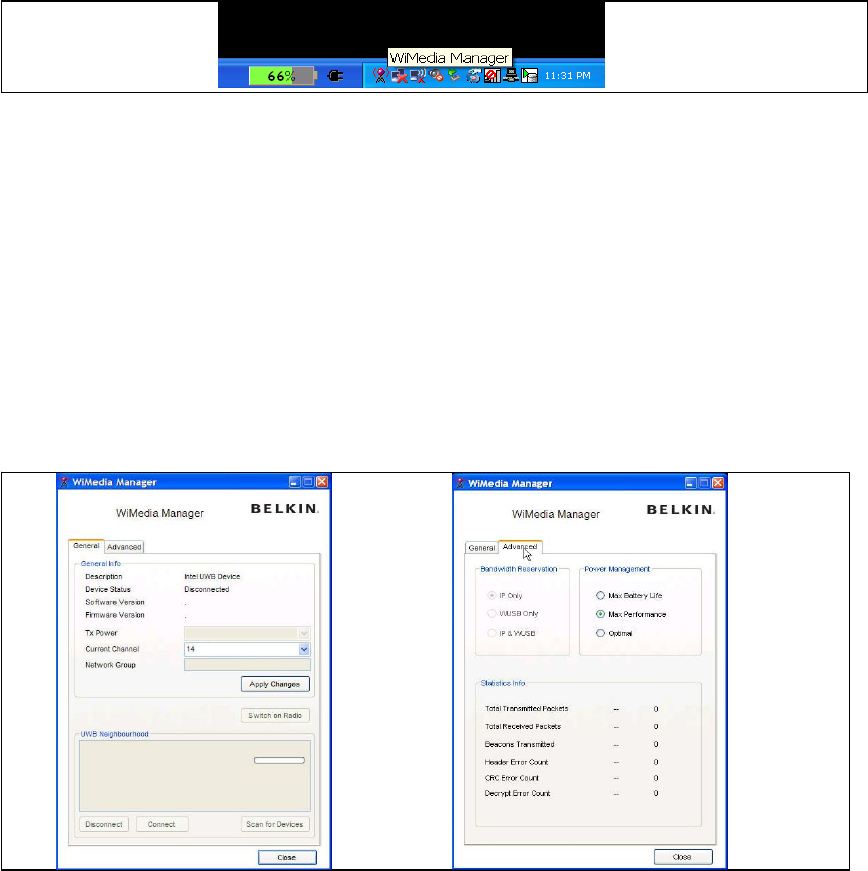
Revision 0.25 - 17 -
How to use Belkin(R) WiMedia Manager
The Belkin WiMedia Manager is installed as a startup item as part of the Belkin
Wireless UWB Link software installation and will be running as a background task.
The WiMedia Manager can be located on the notification area of the Microsoft*
Windows status bar as shown in the Figure 21.
Figure 21 WiMedia Manager on the Notification Area
The WiMedia Manager is functionally classified into General View and Advanced View
as illustrated in the figure below.
The General View will list the features:
• Device Status – RADIO ON/OFF
• Establish UWB Connections, disconnect a UWB Connection,
• Change channel numbers,
• Scan for UWB Devices
• Listing of Software/Firmware version for maintenance purpose
The Advanced View will list the features:
• Bandwidth Reservation
• Power Management
• Statistics for existing UWB Connections
Figure 22 WiMedia Manager – General and Advanced View
Revision 0.25 - 18 -
Uninstallation
If you need to uninstall the software, follow the procedure outlined below.
Uninstall Belkin(R) Wireless UWB Link Software
Please follow the steps indicated below to uninstall the Belkin(R) Wireless UWB Link
software which was installed prior:
1. Go to Add or Remove Programs by clicking Start Menu -> Control Panel -> Add
or Programs
2. Identify Belkin(R) Wireless UWB Link software and Click the Remove button to
Uninstall
3. The Install Shield wizard will ask “Do you want to completely remove the selected
application and its features?” Click the Yes button.
4. After successful Uninstall, the Uninstall Complete Dialog will be displayed. Click
the Finish button to close the dialog.
Uninstall Belkin(R) Wireless UWB Link Drivers
The following sequence of un-installation of the drivers is recommended.
- Intel(R) Wireless UWB Link 1480M USB WiNet Adapter
- Intel(R) Wireless UWB Link 1480M Control Driver
1. Insert the Belkin dongle into the USB port of the personal computer/laptop.
2. Go to the Device Manager.
3. Under Network Adapters:
- Right Click on Intel(R) Wireless UWB Link 1480M USB WiNet Adapter and
select Uninstall.
4. Under Universal Serial Bus Controller:
- Right Click on Intel(R) Wireless UWB Link 1480M Control Driver and
select Uninstall.
Uninstall Intel(R) UWB Device Firmware Utility (DFU) Driver (This
may not be required)
The DFU device is not listed in the Device manager, we recommend to delete the file
DfuUWB.sys from the location C:\Windows\System32\drivers.
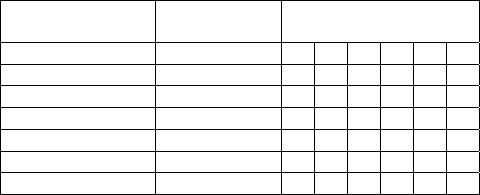
Revision 0.25 - 19 -
Channel Selection
The Belkin(R) dongle will operate in Band Group 1 mode only. The channels
supported within the Band Group1 are listed in the Table 1. If there are multiple
dongles, you may choose to operate the dongles in different channels for
simultaneous operations. The default channel Belkin dongle is programmed to
operate in channel number 14.
Channel
Number TFC Code Band ID
9 1 1 2 3 1 2 3
10 2 1 3 2 1 3 2
11 3 1 1 2 2 3 3
12 4 1 1 3 3 2 2
13 5 1 1 1 1 1 1
14 6 2 2 2 2 2 2
15 7 3 3 3 3 3 3
Table 1 PHY Channel Numbers
Multi-Channel Operations
If there’s a need to have simultaneous UWB connections, you may choose to operate
these systems in different channel numbers without any interference. Before
inserting the Belkin dongles, open the WiMedia Manager and change the channel
number appropriately.
Revision 0.25 - 20 -
Troubleshooting
1. Why does the Belkin Dongle not work on laptops which have USB 1.0/1.1 ports?
The Belkin dongle is designed to work for USB 2.0 and hence you can see the
performance greater than USB 1.0/1.1.
2. Does your computer support USB 2.0?
To determine if your computer supports USB 2.0, follow the steps below:
Step 1: Go to the Device Manager Start -> All Programs -> Control Panel -> System ->
Hardware (Tab) -> Click Device Manager.
Step 2: In Device Manager, Under Universal Bus Controllers check for the entry
Enhanced Host Controller.
Customer Support
FCC Statement
This device complies with part 15 of the FCC Rules. Operation is subject to the
following two conditions: (1) this device may not cause harmful interference, and (2) this
device must accept any interference received, including interference that may cause
undesired operation.
Changes or modifications to this device not expressly approved Belkin could void the
user’s authority to operate the equipment under the FCC grant of equipment authorization
issued to Belkin
Information
Electromagnetic Interference (EMI) is any signal or emission, radiated in free space or
conducted along power or signal leads, that endangers the function of radio navigation or
other safety service (the telephone and cellphones are considered to be safety services) or
seriously degrades, obstructs or repeatedly interrupts a licensed radio communications
service. Radio communications services include but are not limited to: AM/FM
commercial broadcast, television, cellular services, radar, air traffic control, pager and
personal communications services (PCS). These licensed services, along with
unintentional radiators such as digital devices, including computer systems, contribute to
the electromagnetic environment.
Electromagnetic Compatibility (EMC) is the ability of items of electronic equipment to
function properly together in the electromagnetic environment. While this device has
Revision 0.25 - 21 -
been designed and determined to be compliant with regulatory agency limits for EMI,
there is no guarantee that interference will not occur in a particular installation. If this
device does cause interference with radio communications services, which can be
determined by turning the device on and off, you are encouraged to try to correct the
interference by one or more of the following measures:
• Re orient the receiving antenna
• Relocate the device with respect to the victim receiver
• Move the device away from the victim receiver
• Plug the device host into a different power outlet than the victim receiver so that
the device system and receiver are on separate branch circuits
If necessary, consult your system service representative or an experienced
radio/television technician for additional help in resolving interference.